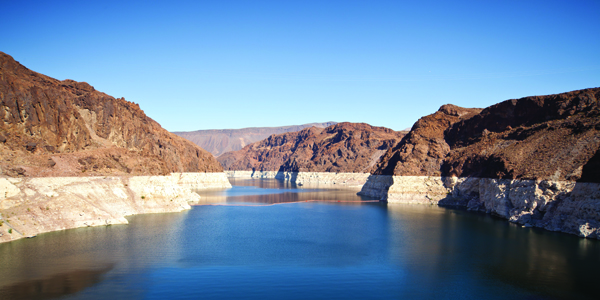Water agencies across Arizona, California and Nevada, together with the Department of the Interior, today announced a historic effort to invest up to $200 million in projects over the next two years to keep the Colorado River’s largest reservoir, Lake Mead, from dropping to critically low levels.
The agreement, known as the 500+ Plan, aims to add 500,000 acre-feet of additional water to Lake Mead in both 2022 and 2023 by facilitating actions to conserve water across the Lower Colorado River Basin. The additional water – enough water to serve about 1.5 million households a year – would add about 16 feet total to the reservoir’s level, which continues to reach record low levels.
“Two decades of drought on the Colorado River is taking a toll across the Basin and on Lake Mead. By working together we’ve staved off these historic low levels for years, thanks to collaboration and conservation in the Lower Basin. But we need even more action, and we need it now,” said Commissioner Camille Calimlim Touton of the U.S. Bureau of Reclamation.
READ ALSO: Some fast facts to know about the Arizona water supply
In addition to Reclamation, the 500+ Plan includes the Arizona Department of Water Resources, Central Arizona Project, The Metropolitan Water District of Southern California, and the Southern Nevada Water Authority.
Under the Memorandum of Understanding signed today during the Colorado River Water Users Association’s annual conference, ADWR commits up to $40 million to the initiative over two years, with CAP, Metropolitan and SNWA each contributing up to $20 million. The federal government plans to match those commitments, for a total funding pool of $200 million.
Some of the specific conservation actions and programs that will be implemented through the 500+ Plan have already begun, while others are still being identified. The MOU includes conservation efforts in both urban and agricultural communities, such as funding crop fallowing on farms to save water, including the recent approval of a short-term agricultural land fallowing program in California, or urban conservation to reduce diversions from Lake Mead.
In 2019, Arizona, Nevada and California signed the Lower Basin Drought Contingency Plan and agreed to contribute water to Lake Mead as it reached certain levels, to keep it from dropping even further and reaching critically low levels. The DCP also included a provision that if modeling indicates a possibility of the reservoir reaching an elevation of 1,030 feet, action would be required.
“Our work on the 2019 DCP took more than five years to complete. This commitment to work together to stabilize Lake Mead came together in a matter of a few months,” said Arizona Department of Water
Resources Director Tom Buschatzke. “That alone is a powerful testament to the commitment of the Lower Basin States to work together with our partners at Reclamation to protect this vital river system.”
“These past months have presented tremendous challenges with the additional pressure of the need to work quickly. But rather than drive us apart, this difficult situation has further strengthened our relationships. It’s amazing that work of this magnitude, sensitivity and expense could come together in this amount of time,” said Central Arizona Project General Manager Ted Cooke.
“We had hoped the contributions made under the DCP would be enough to stabilize Lake Mead while we seek longer-term solutions to the challenges on the Colorado River. But they aren’t, which is why we are moving forward with the 500+ Plan,” said Metropolitan General Manager Adel Hagekhalil.
“It is imperative that all users on the Colorado River take action now to preserve this critical resource that we all depend upon,” said SNWA General Manager John Entsminger. “We hope as this initiative is developed, that along with our other many conservation efforts, it will provide strong support for Lake Mead water levels.”
The plan marks the latest collaborative effort by the Lower Basin states in partnership with Reclamation to bring sustainability to the Colorado River, which has been in a historic drought since 2000.
The plan also highlights the Bipartisan Infrastructure Law’s historic $8.3 billion investment in water infrastructure and will help minimize the impacts of drought, and develop a long-term plan to facilitate conservation and economic growth. The BID’s investments will fund water efficiency and recycling programs, rural water projects, WaterSMART grants and dam safety to ensure that irrigators, Tribes and adjoining communities receive adequate assistance and support.




